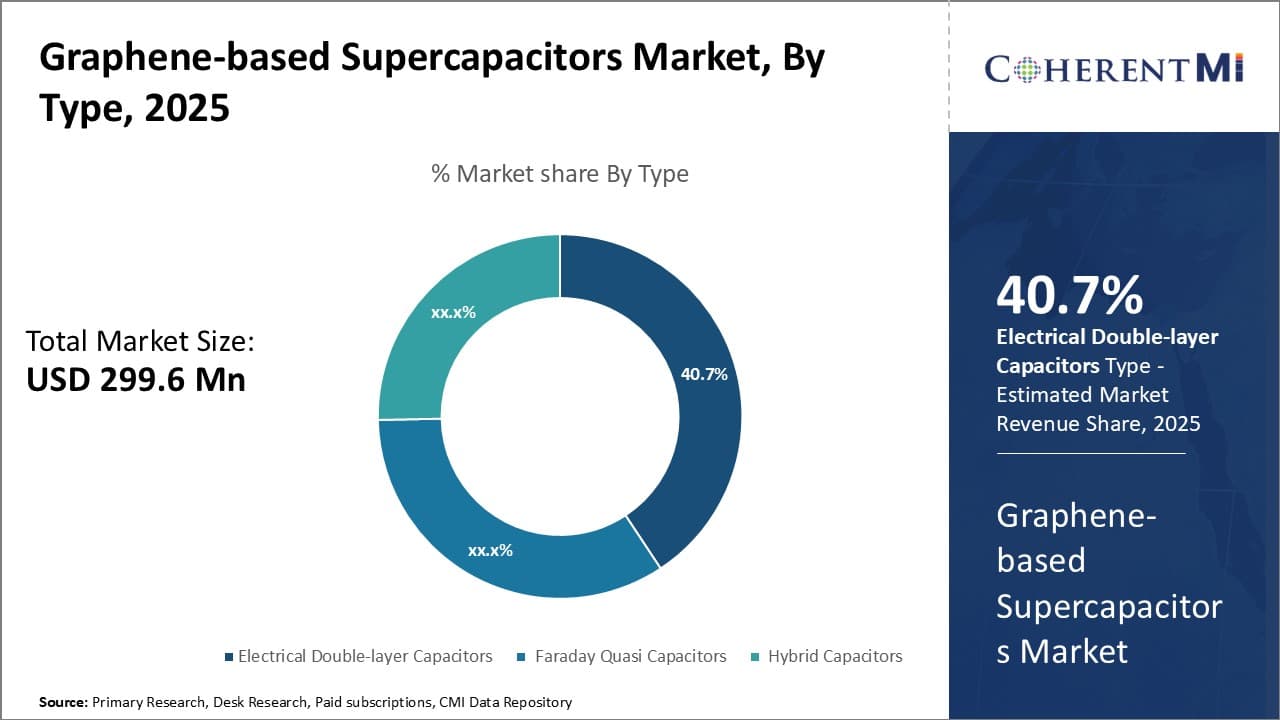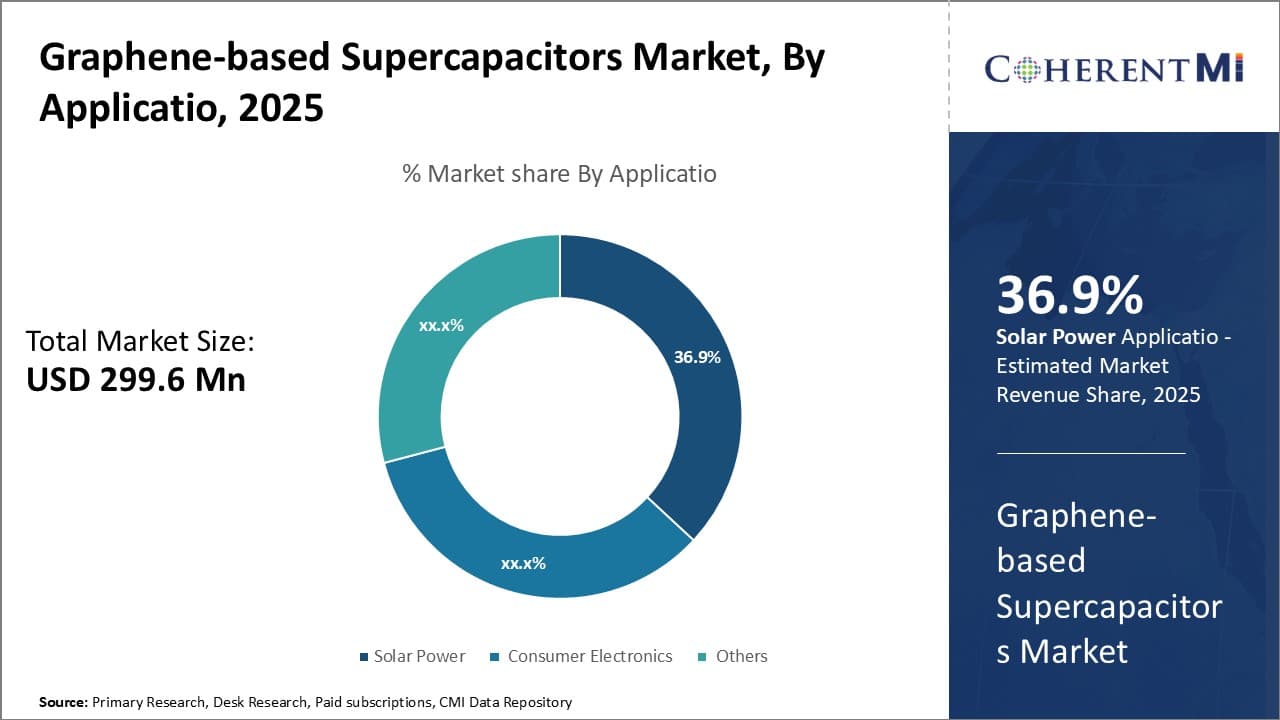

The graphene-based supercapacitors market is estimated to be valued at USD 299.6 Mn in 2025 and is expected to reach USD 1001.2 Mn by 2032, growing at a compound annual growth rate (CAGR) of 22.5% from 2025 to 2032. Graphene-based supercapacitors market is expected to witness significant growth due to the increasing demand for high-performance energy storage devices across various end-use industries.
Market Size in USD Mn
CAGR22.5%
| Study Period | 2025-2032 |
| Base Year of Estimation | 2024 |
| CAGR | 22.5% |
| Market Concentration | Medium |
| Major Players | Angstron Materials, XG Sciences, Bluestone Global Tech, Applied Graphene Materials, Graphene Technologies and Among Others |
Market Driver - High Demand for Energy Storage Solutions in Electronics and EVs
The increasing demand for portable electronic devices and electric vehicles has been fueling the need for better energy storage solutions. However, batteries have limitations in terms of charging time and number of charging cycles before capacity degradation. This has reinforced the need to develop alternative energy storage mediums that can charge devices rapidly and sustain high power levels for thousands of charge-discharge cycles.
Graphene-based supercapacitors have emerged as a promising solution owing to their ability to charge and discharge within seconds. Moreover, graphene-based supercapacitors are safer and more durable than lithium-ion batteries as they do not use potentially explosive liquid electrolytes.
Electric vehicles are another key area driving the demand for advanced energy storage systems. Rapid acceleration and ability to charge EVs quickly are critical for consumer acceptance. Graphene-based supercapacitors show promise in helping address two major pain points of EVs - short driving range between charges and long charging times. This is expected to drive growth of the graphene-based supercapacitors market.
Market Driver - Increasing R&D Activities in Graphene-based Supercapacitors Market
Graphene has been a material of extensive research interest over the past decade owing to its exceptional electrical and mechanical properties. However, leveraging these properties to build practical energy storage devices requires extensive investigation at the laboratory level. Today, numerous university labs and corporate R&D divisions across the world are actively working on new techniques for developing novel electrode architectures.
Notable areas of ongoing R&D in graphene-based supercapacitors include increasing energy density levels closer to lithium-ion batteries. Scientists are experimenting with composite graphene materials, 3D porous structures and electrolytes to enhance capacitance. Likewise, improving power density, operating voltage and cycling lifespan through electrode and cell design optimization is a priority.
Overall, increasing R&D efforts seem certain to drive faster technology maturation and commercialization of next-gen graphene-based supercapacitors.
 To learn more about this report, Download Free Sample Copy
To learn more about this report, Download Free Sample Copy
Market Challenge - High Production Costs for Graphene
One of the major challenges currently faced by the graphene-based supercapacitors market is the high production costs associated with graphene. Graphene has excellent electrical and thermal conductive properties which make it very suitable for applications in supercapacitors. However, the production of graphene at an industrial scale remains a challenge.
Currently, most graphene is produced through an energy-intensive process called chemical vapor deposition which deposits graphene layer-by-layer onto a substrate like copper or silicon carbide. The cost of equipment required for chemical vapor deposition and the intricate processes involved drive up the costs associated with graphene production.
Additionally, the low sample yields from chemical vapor deposition further contribute to higher per-unit costs. Market players will need to focus on developing lower cost and higher throughput production techniques to make graphene-based supercapacitors economically viable.
Market Opportunity - Expansion in the Electric Vehicle Industry
One of the major opportunities for the graphene-based supercapacitors market is the expanding electric vehicle industry. With stringent regulations and policies being imposed worldwide to curb vehicular emissions and push for greater adoption of electric vehicles, the electric vehicle market is expected to grow substantially in the coming years.
Graphene-based supercapacitors offer higher power densities and cycling stability compared to conventional capacitors and lithium-ion batteries. Their ability to charge and discharge rapidly makes them ideally suitable for energy recuperation and storage applications in electric vehicles.
As the electric vehicle market expands globally driven by factors like sustainability, graphene supercapacitor manufacturers stand to significantly benefit given their technological superiority. Leveraging the exponential electric vehicle growth can help accelerate the commercialization and market penetration of graphene-based supercapacitors.
Research and Development: R&D is one of the most important strategies adopted by players to gain an edge in this emerging market. For example, GrapheneX, a leading UK-based graphene company, invested over $5 million in R&D between 2015-2018 to develop new graphene materials tailored for supercapacitor applications. This helped them launch the first commercial graphene-based supercapacitors in 2019.
Strategic Partnerships and Collaborations: Players are forming strategic partnerships with material developers, manufacturers and end-users to derisk technological challenges and facilitate adoption.
Business Model Innovation: Some players have differentiated their business models to gain an early mover advantage. For example, NanoGraf Coatings switched to a 'Materials as a Service' model in 2020, licensing their patented graphene inks and coatings to OEMs instead of selling final products. This enabled faster scale-up.
 To learn more about this report, Download Free Sample Copy
To learn more about this report, Download Free Sample Copy
Insights, By Type: Electrical Double-layer Capacitors Witness Widespread Applications and Technical Superiority
The graphene-based supercapacitors market by type is currently dominated by electrical double-layer capacitors (EDLCs) with 40.7% market share. EDLCs contribute the highest share due to their unique properties that make them highly suitable for a wide variety of applications.
EDLCs store electrical charges at the interface between an electrode and electrolyte through non-Faradaic surface adsorption/desorption of ions. This allows them to rapidly charge and discharge efficiently through billions of cycles with very low equivalent series resistance (ESR). Their non-Faradaic charge storage mechanism also gives them an exceptional ability to deliver extremely high-power density over short durations.
Additionally, graphene's high surface area, exceptional conductivity, and chemical stability make it highly beneficial for EDLC electrodes. Graphene-based EDLC electrodes are able to achieve very high specific capacitance values along with improved power densities. This has further enhanced EDLCs' technical superiority for high-power applications and boosted their market dominance over other capacitor technologies.
 To learn more about this report, Download Free Sample Copy
Insights, By Application: Solar Power Segment is Driven by the Need for Efficient Energy Storage
To learn more about this report, Download Free Sample Copy
Insights, By Application: Solar Power Segment is Driven by the Need for Efficient Energy Storage
The graphene-based supercapacitors market by application is currently led by the solar power industry with 36.9% revenue share. There is growing demand for efficient and long-lasting energy storage solutions in solar power generation and distribution which is driving the higher market share of this segment.
The intermittent nature of solar energy necessitates robust energy storage systems that can take up fluctuating generation outputs and provide power on demand reliably around the clock. At the same time, the large-scale integration of solar farms onto national grids requires storage technologies to balance and stabilize power quality by smoothing out supply variability issues.
They also eliminate capacity fading issues of batteries through a non-Faradaic mechanism. This maintains a long, predictable working life essential for distributed solar systems with limited maintenance access. As energy policies increasingly mandate grid-scale renewable integration worldwide, graphene-based supercapacitors' technical leadership is driving accelerated adoption in the booming solar power segment in graphene-based supercapacitors market.
The major players operating in the graphene-based supercapacitors market include Angstron Materials, XG Sciences, Bluestone Global Tech, Applied Graphene Materials, Graphene Technologies, Graphene 3D Lab, Vorbeck Materials, Skeleton Technologies, Nanotech Energy, Angstron Materials, Maxwell Technologies (Tesla), and Global Graphene Group.
Would you like to explore the option of buying individual sections of this report?
As an accomplished Senior Consultant with 7+ years of experience, Pooja Tayade has a proven track record in devising and implementing data and strategy consulting across various industries. She specializes in market research, competitive analysis, primary insights, and market estimation. She excels in strategic advisory, delivering data-driven insights to help clients navigate market complexities, optimize entry strategies, and achieve sustainable growth.
Graphene-based Supercapacitors Market, By Type (Electrical Double-layer Capacitors, Faraday Quasi Ca...
Graphene-based Supercapacitors Market
How big is the graphene-based supercapacitors market?
The graphene-based supercapacitors market is estimated to be valued at USD 299.6 Mn in 2025 and is expected to reach USD 1240.2 Mn by 2032.
What are the key factors hampering the growth of the graphene-based supercapacitors market?
High production costs for graphene and challenges in scaling graphene production to industrial levels are the major factors hampering the growth of the graphene-based supercapacitors market.
What are the major factors driving the graphene-based supercapacitors market growth?
High demand for energy storage solutions in electronics and EVs and increasing R&D activities in graphene-based supercapacitors are the major factors driving the graphene-based supercapacitors market.
Which is the leading type in the graphene-based supercapacitors market?
The leading type segment is electrical double-layer capacitors.
Which are the major players operating in the graphene-based supercapacitors market?
Angstron Materials, XG Sciences, Bluestone Global Tech, Applied Graphene Materials, Graphene Technologies, Graphene 3D Lab, Vorbeck Materials, Skeleton Technologies, Nanotech Energy, Angstron Materials, Maxwell Technologies (Tesla), and Global Graphene Group are the major players.
What will be the CAGR of the graphene-based supercapacitors market?
The CAGR of the graphene-based supercapacitors market is projected to be 22.5% from 2025-2032.